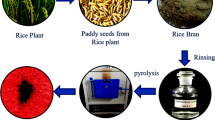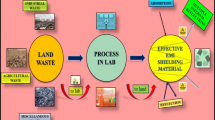Abstract
Tetra Pak packages (Tetra paks) are one of typical paper/plastic/aluminum composites and widely used in soft drinks and dairy product markets. However, after its service life, serious environmental problems generate due to its non-biodegradable nature. In this paper, a novel electromagnetic interference (EMI) shielding board was developed using recycled Tetra paks waste with addition of iron fibers. The influence of fiber loading level, fiber length and number of iron fiber layer within the matrix on EMI shielding effectiveness (SE) and volume resistivity (VR) was investigated. The results indicated that fiber loading level, fiber length and number of iron fiber layer affected EMI shielding properties significantly. SE increased with the increasing fiber loading, fiber length and number of fiber layer, and VR had an opposite tendency. For the board with 5 mm thickness, the percolation threshold of fiber loading was between 0.008 and 0.02 % (weight of iron fiber/weight of Tetra paks). The boards had excellent total EMI shielding performance in range of 9000 Hz–200 MHz and 600–1500 MHz. This value-added product could be used in packaging, construction and other application fields and exhibited both environmental and economic advantages. It also could be considered as a step toward paper/plastic/aluminum composite waste management and preventing municipal solid wastes environmental pollution.






Similar content being viewed by others
References
Pan Y, Tian F (2011) Discussion on the present situation and recycling scheme for Tetra Pak package. Ecol Econ 5:154–156
Cui ZW (2009) Study of recycling technology for paper based composite. Shanghai paper 40 3:62–67
Wang L (2006) Discussion on printing and recovery process of Tetra Pak package. Packag Eng 6:79–81
Jiang YQ (2008) Discussion on the recycling of aluminum paper plastic composite. Chin High-Tech Enterp 11:151
Ayrilmis N, Candan Z, Hiziroglu S (2008) Physical and mechanical properties of cardboard panels made from used beverage carton with veneer overlay. Mater Des 29:1897–1903
Li N, Xiong XL (2008) Study on the separation of aluminum-plastic-paper composite for packaging. Packag Eng 29(12):56–58
Zhang JF, Yan DH (2008) Study on wet process for the separation of paper based aluminum-plastic packaging composite. Res Environ Sci 21(6):99–104
Lu JF, Shen JF, Zhen R (2010) Research and development of the recycling of Tetra Pak package. Guangzhou Chem Ind 39(9):17–18
Hwang G-S, Wang EI-C, Su Y-C (2006) Preparation of composite board using foil-laminated and plastic-laminated liquid packaging paperboard as raw materials. J Wood Sci 52(3):230–235. doi:10.1007/s10086-005-0757-0
Okino EYA, Santana MAE, de Souza MR (2000) Utilization of wastepaper to manufacture low density boards. Bioresour Technol 73:77–79
Saini P, Choudhary V, Singh BP, Mathur RB, Dhawan SK (2009) Polyaniline–MWCNT nanocomposites for microwave absorption and EMI shielding. Mater Chem Phys 113:919–926
Saini P, Arora M (2012) Microwave absorption and EMI shielding behavior of nanocomposites based on intrinsically conducting polymers, graphene and carbon nanotubes. In: Gomes AD (ed) New polymers for special applications. Intech, Croatia. doi:10.5772/48779
Zhang B, Du Y, Zhang P, Zhao H, Kang L, Han X, Xu P (2013) Microwave absorption enhancement of Fe3O4/polyaniline core/shell hybrid microspheres with controlled shell thickness. J Appl Polym Sci 130(3):1909–1916
Yang Y, Gupta MC, Dudley KL, Lawrence RW (2005) Novel carbon nanotube—polystyrene foam composites for electromagnetic interference shielding. Nano Lett 5:2131–2134
Zhou W, Hu X, Bai X, Zhou S, Sun C, Yan J, Chen P (2011) Synthesis and electromagnetic, microwave absorbing properties of core shell Fe3O4 poly(3, 4-ethylenedioxythiophene) microspheres. ACS Appl Mater Interfaces 3(10):3839–3845
Panwar V, Park JO, Park SH, Kumar S, Mehra RM (2010) Electrical, dielectric, and electromagnetic shielding properties of polypropylene–graphite composites. J Appl Polym Sci 115(3):1306–1314
Hu QL, Kim MS (2008) Electromagnetic interference shielding properties of CO2 activated carbon black filled polymer coating materials. Carbon Lett 9(4):298–302
Chung DDL (2001) Review of electromagnetic interference shielding effectiveness of carbon materials. Carbon 39:279–285
Ameli A, Jung PU, Park CB (2013) Electrical properties and electromagnetic interference shielding effectiveness of polypropylene/carbon fiber composite foams. Carbon 60:379–391
Wong KH, Pickering SJ, Rudd CD (2010) Recycled carbon fibre reinforced polymer composite for electromagnetic interference shielding. Comp Part A 41(6):693–702
Li N, Huang Y, Du F, He X, Lin X, Gao H, Ma Y, Li F, Chen Y, Eklund PC (2006) Electromagnetic interference (EMI) shielding of single-walled carbon nanotube epoxy composites. Nano Lett 6:1141–1145
Saini P, Choudhary V (2013) Enhanced electromagnetic interference shielding effectiveness of polyaniline functionalized carbon nanotubes filled polystyrene composites. J Nanopart Res 15:1415
Saini P, Choudhary V (2013) Enhanced electromagnetic interference shielding effectiveness of polyaniline functionalized carbon nanotubes filled polystyrene composites. J Nanopart Res 15:1415
Tripathi SN, Saini P, Gupta D, Choudhary V (2013) Electrical and mechanical properties of PMMA/reduced grapheme oxide nanocomposites prepared via in situ polymerization. J Mater Sci 48:6223–6232. doi:10.1007/s10853-013-7420-8
Wang T, Liu Zh, Lu M, Wen B, Ouyang Q, Chen Y, Zhu Ch, Gao P, Li Ch, Cao M, Qi L (2013) Graphene–Fe3O4 nanohybrids: synthesis and excellent electromagnetic absorption properties. J Appl Phys 113:024314. http://dx.doi.org/10.1063/1.4774243
Saini P, Choudhary V (2013) Structural details, electrical properties, and electromagnetic interference shielding response of processable copolymers of aniline. J Mater Sci 48:797–804
Shui X, Chung DDL (1997) Nickel filament polymer–matrix composites with low surface impedance and high electro magnetic interference shielding effectiveness. J Electron Mater 26(8):928–934
Bagwell RM, McManaman JM, Wetherhold RC (2006) Short shaped copper fibers in an epoxy matrix: their role in a multifunctional composite. Comp Sci Technol 66(3–4):522–530
Geng LP (2009) The metal fiber materials for electromagnetic shielding. Equip Mach 4:68–73
Xu CY, Liu J, Zhu XD (2012) Electromagnetic shielding boards produced with Tetra Paks waste and metal fibers. Adv Mater Res 518–523:3349–3357. doi:10.4028/www.scientific.net/AMR.518-523.3349
Xu CY, Liu J, Zhu XD (2012) Production of electromagnetic shielding boards using paper/plastic/aluminum packaging waste and copper fibers. Appl Mech Mater 200:254–258
Jalali M, Dauterstedt S, Michaud A, Wuthrich R (2011) Electromagnetic shielding of polymer-matrix composites with metallic nanoparticles. Compos B. doi:10.1016/j.compositesb
Roh J-S, Chi Y-S, Kang TJ, Nam S-W (2008) Electromagnetic shielding effectiveness of multifunctional metal composite fabrics. Text Res J 78(9):825–835
Lu KY, Fu F, Cai ZY, Fu YJ et al (2011) Study of properties of electromagnetic shielding plywood laminated with conductive sheets. J Build Mater 14(2):207–211
Xu M, Ma TR, Bao HQ (2011) Study of electromagnetic shielding properties of composite enforced by glass fiber. Eng Plast Appl 39(4):15–18
Xie N, Jiao QJ, Zang CG, Liu S (2006) Study on the properties of LDPE-nickel/crystal iron fiber electromagnetic shielding packaging material. Packag Eng 27(1):10–12
Faisal M, Khasim S (2013) Electrical conductivity, dielectric behavior and EMI shielding effectiveness of polyaniline-yttrium oxide composites. Bull Korean Chem Soc 34(1):99–106
Guo Z, Tan L (2009) Fundamentals and applications of nanomaterials. Artech House, Norwood
GB1410-2006/IEC20093 (1980) IDT: methods of test for volume resistivity and surface resistivity of solid electrical insulating materials, Chian
Schulz RB, Plantz VC, Brush DR (1988) Shielding theory and practice. IEEE Trans Electromagn Compat 30(3):187–201
Saini P, Arora M, Gupta G, Gupta BK, Singh VN, Choudhary V (2013) High permittivity polyaniline–barium titanate nanocomposites with excellent electromagnetic interference shielding response. Nanoscale 5:4330–4346. doi:10.1039/C3NR00634D
Saini P, Arora M (2013) Formation mechanism, electronic properties and microwave shielding by nano-structured polyanilines prepared by template free route using surfactant dopants. J Mater Chem A 1:8926–8934. doi:10.1039/C3TA11086A
Saini P, Choudhary V, Vijayan N, Kotnala RK (2012) Conducting polymer coated textile based multilayered shields for suppression of microwave radiations in 8.2–12.4 GHz range. J Phys Chem C 116:13403–13412. doi:10.1021/jp302131w
SJ 20524-1995 (1995) Measuring methods for shielding materials, China
Yang SY (2006) Electromagnetic shielding theory and practice. National Defense Industry Press, China
Zhang LW, Li XH (2010) Design and computational method of engineer electromagnetic shielding in EMC. Ship Power Technol 30(1):35–40
Lin HB, Lu WS (2008) The principle of electromagnetic shielding and the electromagnetic shielding glass. Glass 3:39–42
Miyasaka K, Watanabe K, Jojima E, Aida H, Sumita M, Ishikawa K (1982) Electrical conductivity of carbon-polymer composites as a function of carbon content. J Mater Sci 17(6):1610–1616
Vilčáková J, Sahá P, Quadrat O (2000) Electrical conductivity of carbon fibres/polyester resin composites in the percolation threshold region. Eur Polymer J 38:2343–2347
Jiang Y, Wang G (2005) Application of electromagnetic shielding glass in electromagnetic shielding shelter. Shield Technol Mater 1:37–39
Fu F, Lu B, Wang ZT, Hua YK (2001) Percolation threshold of electrically conductive function in wood-based composite panels. Sci Silvae Sin 37(1):117–120
Acknowledgments
This work was financially supported by “A Project Funded by the Priority Academic Program Development of Jiangsu Higher Education Institutions (PAPD)” and “Jiangsu Overseas Research & Training Program for University Prominent Young & Middle-aged Teachers and Presidents”. The authors great appreciate Hainan Kunlun New Material Science & Technology Co., Ltd. for sample preparation. The authors would also like to thank Mr. Lu and Mr. Jang at Research Institute of Wood Industry, Chinese Academy of Forestry, for the EMI SE test of the composites.
Author information
Authors and Affiliations
Corresponding author
Rights and permissions
About this article
Cite this article
Xu, C., Liu, J., Zhu, X. et al. Electromagnetic interference shielding boards produced using Tetra Paks waste and iron fiber. J Mater Cycles Waste Manag 17, 391–398 (2015). https://doi.org/10.1007/s10163-014-0255-9
Received:
Accepted:
Published:
Issue Date:
DOI: https://doi.org/10.1007/s10163-014-0255-9




